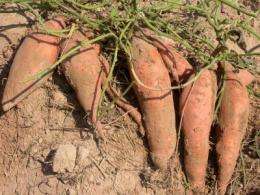Sweetpotato foundation seed tested in commercial operations

Sweetpotato is gaining popularity in the United States, where health-conscious consumers have created increased demand for the tasty, versatile food. According to the U.S. Department of Agriculture, per capita consumption of the crop increased over 24% from 1998-2008 and the value of the U.S. sweetpotato crop in 2009 exceeded $400 million.
Production costs for sweetpotato crops are high, requiring that commercial growers optimize their production techniques and quality to keep up with consumer demand. Because sweetpotato is vegetatively propagated, viruses and mutations can accumulate readily, leading to plant decline. To maintain the integrity of commercial seed stock, sweetpotato foundation seed programs in the United States provide virus-tested foundation seed to commercial producers.
To better understand how rapidly the foundation seed declines after integration into commercial operations and to determine if production location affects decline, researchers conducted a study to evaluate changes in seed quality among farms in the major sweetpotato production areas of Louisiana. The results appeared in HortTechnology. "Although preliminary evaluations indicated that low incidence of re-infection with viruses can occur during the production of foundation seed, little information was available to evaluate how rapidly seed productivity and quality declined on farms, where older generations of sweetpotato are also grown and could serve as sources of inoculum for reinfection of new seed.", explained Christopher Clark, a Louisiana State University faculty member and lead author of the study.
G1 seed (seed grown 1 year after virus therapy in the foundation seed production field at the Sweet Potato Research Station, Louisiana State University Agricultural Center) was used as a reference to compare the yield and virus incidence of growers' generation 2 (G2) and generation 3 (G3) seed roots (grown in the growers' seed production fields 1or 2 years following the year of foundation seed production). "Although yields of plants grown from G2 and G3 seed were 86.3% and 86.1% for U.S. No. 1 and 83.3% and 86.0% for total marketable, respectively, compared with the yields from G1 seed, they were not significantly different", the scientists reported. Yield and virus incidence data suggested that seed quality may vary from year to year and from location to location.
Clark said that study results suggest that producers are indeed realizing yield benefits by incorporating virus-tested foundation seed into their production schemes. "It is also evident from the data that there is a decline in performance once this seed is increased on commercial farms in close proximity to older, infected propagating material. If the rate of virus re-infection on farms could be reduced, it appears that further improvements in yield could be realized", he added.
The scientists recommended that future studies should investigate methods that have proven useful on other crops, such as border crops, and the use of stylet oil sprays to reduce virus transmission. Additionally, clean seed programs should be augmented with enhanced virus resistance, tolerance, or both.
More information: horttech.ashspublications.org/ … nt/abstract/20/6/977
Provided by American Society for Horticultural Science



















